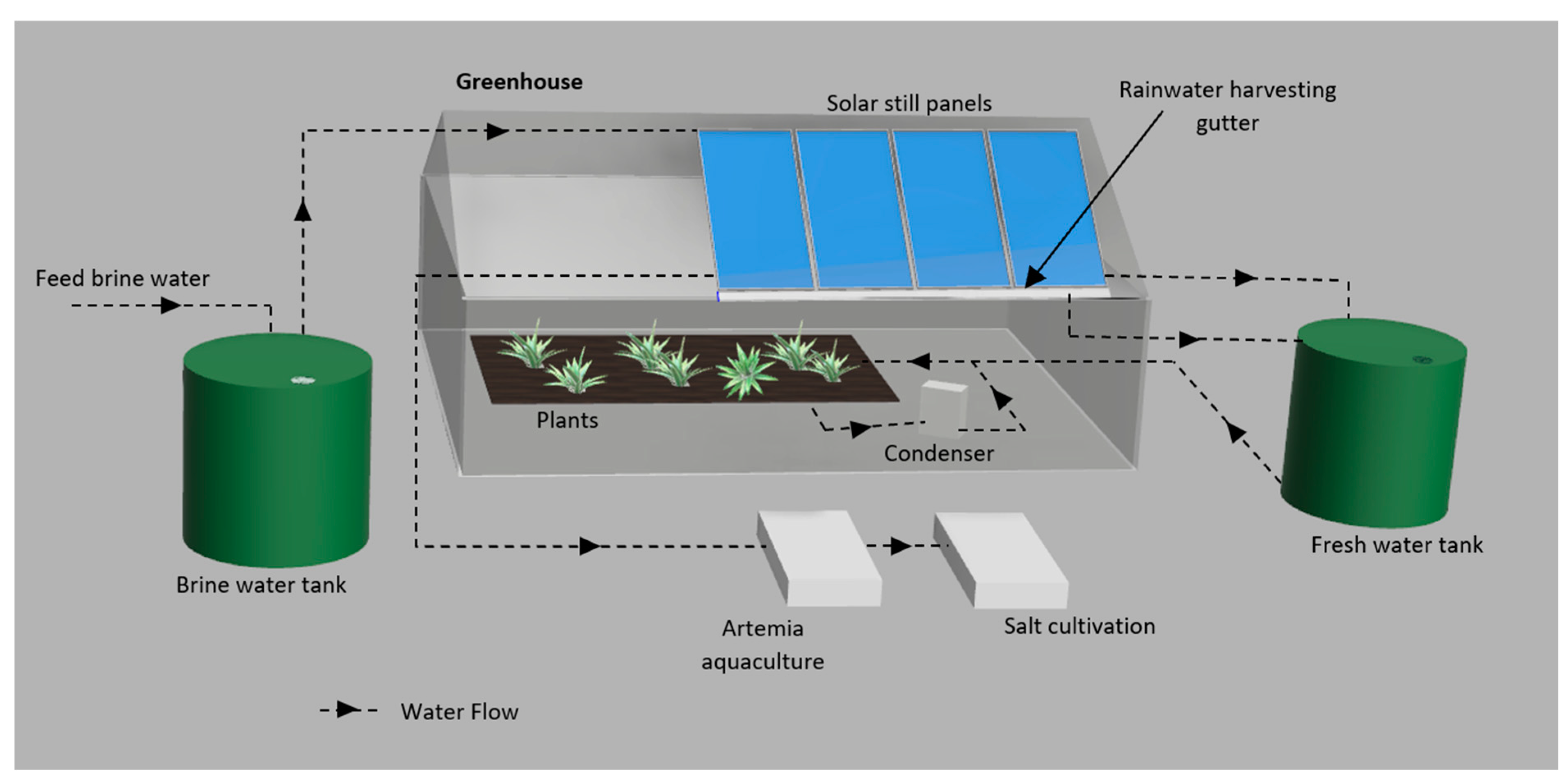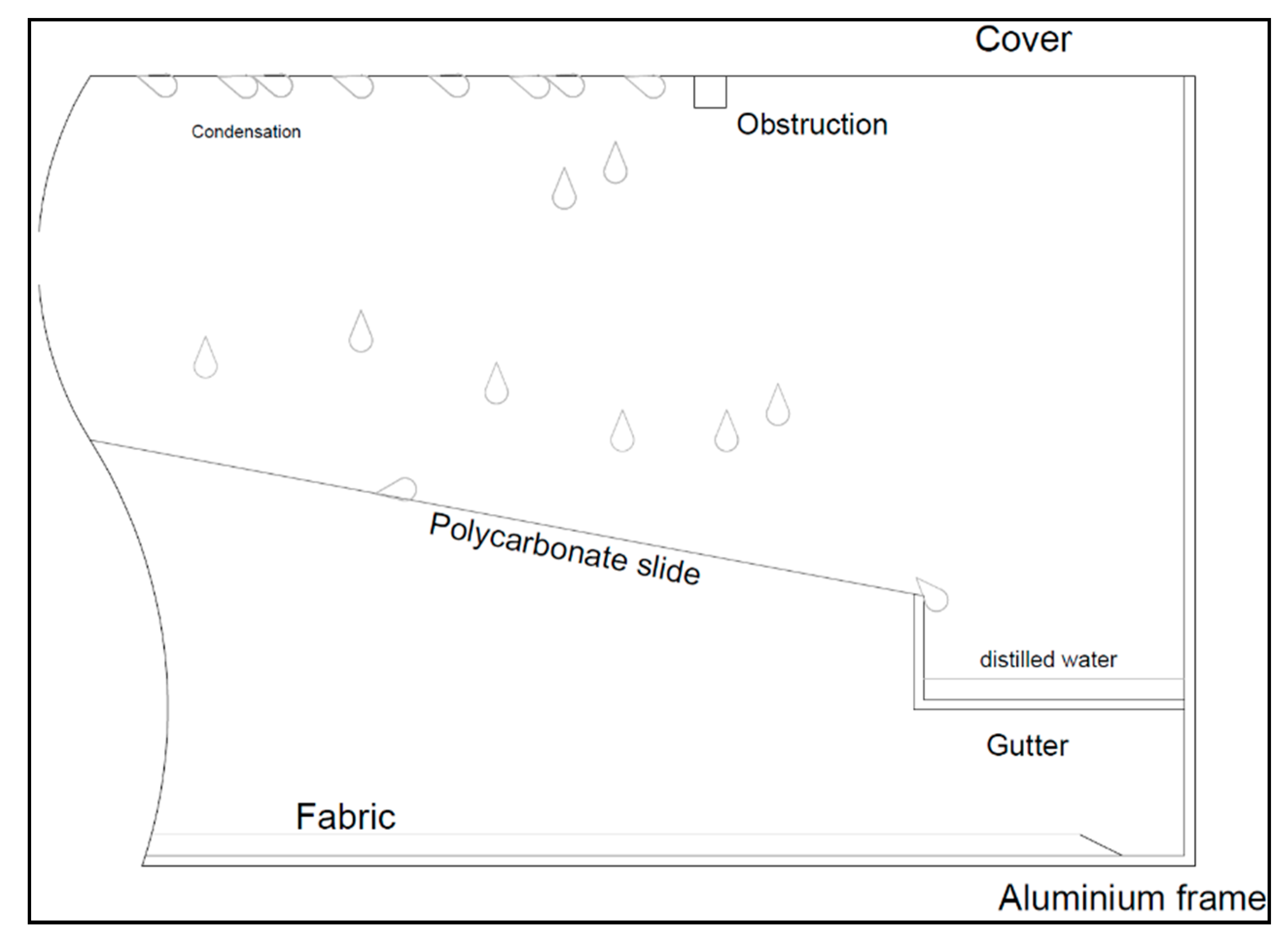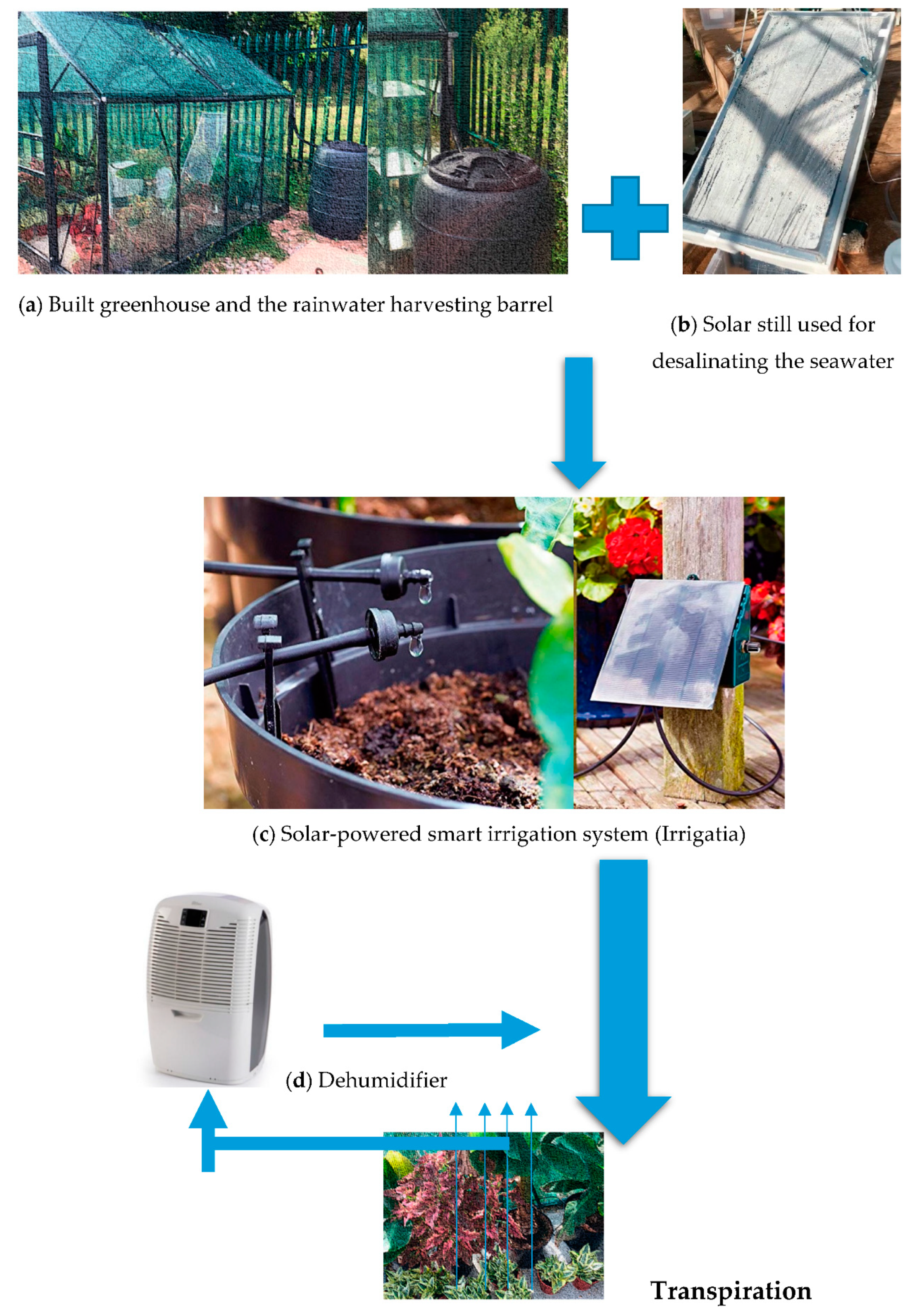A Zero-Liquid Discharge Model for a Transient Solar-Powered Desalination System for Greenhouse
Abstract
:1. Introduction
2. Materials and Methods
3. Results
3.1. Greenhouse in UK
3.2. Greenhouse in Egypt
4. Discussion
5. Conclusions
Author Contributions
Funding
Acknowledgments
Conflicts of Interest
References
- Hassan, G.E.; Salah, A.H.; Fath, H.; Elhelw, M.; Hassan, A.M.; Saqr, K.M. Optimum operational performance of a new stand-alone agricultural greenhouse with integrated-TPV solar panels. Sol. Energy 2016, 136, 303–316. [Google Scholar] [CrossRef]
- Akrami, M.; Salah, A.H.; Javadi, A.; Fath, H.; Hassanein, M.; Farmani, R.; Dibaj, M.; Negm, N.A. Towards a Sustainable Greenhouse: Review of Trends and Emerging Practices in Analysing Greenhouse Ventilation Requirements to Sustain Maximum Agricultural Yield. Sustainability 2020, 12, 2794. [Google Scholar] [CrossRef] [Green Version]
- Akrami, M.; Javadi, A.; Hassanein, M.; Farmani, R.; Dibaj, M.; Tabor, G.R.; Negm, N.A. Study of the Effects of Vent Configuration on Mono-Span Greenhouse Ventilation Using Computational Fluid Dynamics. Sustainability 2020, 12, 986. [Google Scholar] [CrossRef] [Green Version]
- Sablani, S.; Goosen, M.; Paton, C.; Shayya, W.; Al-Hinai, H. Simulation of fresh water production using a humidification-dehumidification seawater greenhouse. Desalination 2003, 159, 283–288. [Google Scholar] [CrossRef]
- Goosen, M.; Sablani, S.; Paton, C.; Perret, J.; Al-Nuaimi, A.; Haffar, I.; Al-Hinai, H.; Shayya, W. Solar energy desalination for arid coastal regions: Development of a humidification–dehumidification seawater greenhouse. Sol. Energy 2003, 75, 413–419. [Google Scholar] [CrossRef]
- Zarei, T.; Behyad, R.; Abedini, E. Study on parameters effective on the performance of a humidification-dehumidification seawater greenhouse using support vector regression. Desalination 2018, 435, 235–245. [Google Scholar] [CrossRef]
- Yunis, H.; Elad, Y.; Mahrer, Y. Effects of air temperature, relative humidity and canopy wetness on gray mold of cucumbers in unheated greenhouses. Phytoparasitica 1990, 18, 203–215. [Google Scholar] [CrossRef]
- Fernández, M.D.; Bonachela, S.; Orgaz, F.; Thompson, R.B.; Lopez, J.C.; Granados, M.R.; Gallardo, M.; Fereres, E.; Bonachela, S. Measurement and estimation of plastic greenhouse reference evapotranspiration in a Mediterranean climate. Irrig. Sci. 2010, 28, 497–509. [Google Scholar] [CrossRef] [Green Version]
- Rizzuti, L.; Ettouney, H.M.; Cipollina, A. Solar Desalination for the 21st Century: A Review of Modern Technologies and Researches on Desalination Coupled to Renewable Energies; Springer Science & Business Media: Berlin, Germany, 2007. [Google Scholar]
- Siddiqui, O.; Dincer, I. Examination of a new solar-based integrated system for desalination, electricity generation and hydrogen production. Sol. Energy 2018, 163, 224–234. [Google Scholar] [CrossRef]
- Ahmadvand, S.; Abbasi, B.; Azarfar, B.; Elhashimi, M.; Zhang, X.; Abbasi, B. Looking Beyond Energy Efficiency: An Applied Review of Water Desalination Technologies and an Introduction to Capillary-Driven Desalination. Water 2019, 11, 696. [Google Scholar] [CrossRef] [Green Version]
- Ranade, V.V.; Bhandari, V.M. Industrial Wastewater Treatment, Recycling, and Reuse; Elsevier BV: Amsterdam, The Netherland, 2014; pp. 1–80. [Google Scholar]
- Tong, T.; Elimelech, M. The Global Rise of Zero Liquid Discharge for Wastewater Management: Drivers, Technologies, and Future Directions. Environ. Sci. Technol. 2016, 50, 6846–6855. [Google Scholar] [CrossRef] [PubMed]
- Burn, S.; Hoang, M.; Zarzo, D.; Olewniak, F.; Campos, E.; Bolto, B.; Barron, O. Desalination techniques—A review of the opportunities for desalination in agriculture. Desalination 2015, 364, 2–16. [Google Scholar] [CrossRef]
- Sauvet-Goichon, B. Ashkelon desalination plant—A successful challenge. Desalination 2007, 203, 75–81. [Google Scholar] [CrossRef]
- Hsu, S.; Cheng, K.; Chiou, J. Seawater desalination by direct contact membrane distillation. Desalination 2002, 143, 279–287. [Google Scholar] [CrossRef]
- Joyce, A.; Loureiro, D.; Rodrigues, C.; Castro, S. Small reverse osmosis units using PV systems for water purification in rural places. Desalination 2001, 137, 39–44. [Google Scholar] [CrossRef]
- Manikandan, V.; Shanmugasundaram, K.; Shanmugan, S.; Janarthanan, B.; Chandrasekaran, J. Wick type solar stills: A review. Renew. Sustain. Energy Rev. 2013, 20, 322–335. [Google Scholar] [CrossRef]
- Edalatpour, M.; Aryana, K.; Kianifar, A.; Tiwari, G.; Mahian, O.; Wongwises, S. Solar stills: A review of the latest developments in numerical simulations. Sol. Energy 2016, 135, 897–922. [Google Scholar] [CrossRef]
- Cooper, P. The maximum efficiency of single-effect solar stills. Sol. Energy 1973, 15, 205–217. [Google Scholar] [CrossRef]
- Montoya-Marquez, O.; Flores-Prieto, J.J. The Effect of the Angle of Inclination on the Efficiency in a Medium-Temperature Flat Plate Solar Collector. Energies 2017, 10, 71. [Google Scholar] [CrossRef] [Green Version]
- Poblete, R.; Salihoğlu, G.; Salihoğlu, N.K. Investigation of the factors influencing the efficiency of a solar still combined with a solar collector. Desalin. Water Treat. 2016, 57, 1–10. [Google Scholar] [CrossRef] [Green Version]
- Sathyamurthy, R.; El-Agouz, S.; Nagarajan, P.K.; Subramani, J.; Arunkumar, T.; MageshBabu, D.; Madhu, B.; Bharathwaaj, R.; Prakash, N. A Review of integrating solar collectors to solar still. Renew. Sustain. Energy Rev. 2017, 77, 1069–1097. [Google Scholar] [CrossRef]
- Postel, S.L.; Daily, G.C.; Ehrlich, P.R. Human Appropriation of Renewable Fresh Water. Science 1996, 271, 785–788. [Google Scholar] [CrossRef]
- Qiblawey, H.; Banat, F. Solar thermal desalination technologies. Desalination 2008, 220, 633–644. [Google Scholar] [CrossRef]
- Kabeel, A.; Bassuoni, M.; Rozza, M. Performance study of an innovative heating technique for a modified solar still. Sci. Iran. 2017, 25, 721–727. [Google Scholar] [CrossRef] [Green Version]
- Mashaly, A.; Alazba, A.; Al-Awaadh, A.; Mattar, M.A. Predictive model for assessing and optimizing solar still performance using artificial neural network under hyper arid environment. Sol. Energy 2015, 118, 41–58. [Google Scholar] [CrossRef]
- Eldalil, K.M. Improving the performance of solar still using vibratory harmonic effect. Desalination 2010, 251, 3–11. [Google Scholar] [CrossRef]
- Jankowski, P.; Garstecki, P. Stable hydrophilic surface of polycarbonate. Sens. Actuators B Chem. 2016, 226, 151–155. [Google Scholar] [CrossRef]
- Coffey, J.; Duddy, J. Self Cleaning, Tubular Solar Still. Google Patents Patent 3,785,931, 15 January 1974. Available online: https://patents.google.com/patent/US3785931A/en?q=Self+Cleaning%2c+Tubular+Solar+Still.&oq=Self+Cleaning%2c+Tubular+Solar+Still (accessed on 10 May 2020).
- Turton, J.; Brown, R. A comparison of a numerical model of radiation fog with detailed observations. Q. J. R. Meteorol. Soc. 1987, 113, 37–54. [Google Scholar] [CrossRef]
- Pillai, R.; Libin, A.T.; Mani, M. Study into solar-still performance under sealed and unsealed conditions. Int. J. Low Carbon Technol. 2013, 10, 354–364. [Google Scholar] [CrossRef] [Green Version]
- Dev, R.; Abdul-Wahab, S.A.; Tiwari, G. Performance study of the inverted absorber solar still with water depth and total dissolved solid. Appl. Energy 2011, 88, 252–264. [Google Scholar] [CrossRef]
- Radhwan, A.M. Transient analysis of a stepped solar still for heating and humidifying greenhouses. Desalination 2004, 161, 89–97. [Google Scholar] [CrossRef]
- Al-Karaghouli, A.; Alnaser, W. Performances of single and double basin solar-stills. Appl. Energy 2004, 78, 347–354. [Google Scholar] [CrossRef]
- Blaga, A. Use of plastics in solar energy applications. Sol. Energy 1978, 21, 331–338. [Google Scholar] [CrossRef] [Green Version]
- Ahmed, S. Study of single-effect solar still with an internal condenser. Sol. Wind. Technol. 1988, 5, 637–643. [Google Scholar] [CrossRef]
- Maalej, A. Solar still performance. Desalination 1991, 82, 197–205. [Google Scholar] [CrossRef]
- Sharshir, S.; Yang, N.; Peng, G.; Kabeel, A. Factors affecting solar stills productivity and improvement techniques: A detailed review. Appl. Therm. Eng. 2016, 100, 267–284. [Google Scholar] [CrossRef]
- Tanaka, H. Tilted wick solar still with flat plate bottom reflector. Desalination 2011, 273, 405–413. [Google Scholar] [CrossRef]
- Tanaka, H.; Nakatake, Y. Improvement of the tilted wick solar still by using a flat plate reflector. Desalination 2007, 216, 139–146. [Google Scholar] [CrossRef]
- Crow, R.M.; Osczevski, R.J. The Interaction of Water with Fabrics. Text. Res. J. 1998, 68, 280–288. [Google Scholar] [CrossRef]
- Omara, Z.; Eltawil, M.A.; Elnashar, E.A. A new hybrid desalination system using wicks/solar still and evacuated solar water heater. Desalination 2013, 325, 56–64. [Google Scholar] [CrossRef]
- Mahdi, J.T. An Experimental and Theoretical Investigation of a Wick-Type Solar Still for Water Desalination. Ph.D. Thesis, Brunel University School of Engineering and Design, Brunel, UK, 1992. [Google Scholar]
- Kofler, P.; Herten, A.; Heinrich, D.; Bottoni, G.; Hasler, M.; Faulhaber, M.; Bechtold, T.; Nachbauer, W.; Burtscher, M. Viscose as an alternative to aramid in workwear: Influence on endurance performance, cooling, and comfort. Text. Res. J. 2013, 83, 2085–2092. [Google Scholar] [CrossRef]
- Narayan, G.P.; Sharqawy, M.H.; Summers, E.K.; Zubair, S.M.; Antar, M. The potential of solar-driven humidification–dehumidification desalination for small-scale decentralized water production. Renew. Sustain. Energy Rev. 2010, 14, 1187–1201. [Google Scholar] [CrossRef]
- Chehayeb, K.M.; Narayan, G.P.; Zubair, S.M. Thermodynamic balancing of a fixed-size two-stage humidification dehumidification desalination system. Desalination 2015, 369, 125–139. [Google Scholar] [CrossRef] [Green Version]
- Xu, L.; Chen, Y.-P.; Wu, P.-H.; Huang, B.-J. Humidification–Dehumidification (HDH) Desalination System with Air-Cooling Condenser and Cellulose Evaporative Pad. Water 2020, 12, 142. [Google Scholar] [CrossRef] [Green Version]
- Yıldırım, C.; Yildirim, C.; Solmuş, I. A parametric study on a humidification–dehumidification (HDH) desalination unit powered by solar air and water heaters. Energy Convers. Manag. 2014, 86, 568–575. [Google Scholar] [CrossRef]
- Giwa, A.; Fath, H.E.; Hasan, S.W. Humidification–dehumidification desalination process driven by photovoltaic thermal energy recovery (PV-HDH) for small-scale sustainable water and power production. Desalination 2016, 377, 163–171. [Google Scholar] [CrossRef]
- Ahmed, M.; Shayya, W.H.; Hoey, D.; Mahendran, A.; Morris, R.; Al-Handaly, J. Use of evaporation ponds for brine disposal in desalination plants. Desalination 2000, 130, 155–168. [Google Scholar] [CrossRef]
- Sorgeloos, P.; Bossuyt, E.; Laviña, E.; Baeza-Mesa, M.; Persoone, G. Decapsulation of Artemia cysts: A simple technique for the improvement of the use of brine shrimp in aquaculture. Aquaculture 1977, 12, 311–315. [Google Scholar] [CrossRef]
- Agh, N.; Van Stappen, G.; Bossier, P.; Sepehri, H.; Lotfi, V.; Rouhani, S.R.; Sorgeloos, P. Effects of salinity on survival, growth, reproductive and life span characteristics of Artemia populations from Urmia Lake and neighboring lagoons. Pak. J. Boil. Sci. 2008, 11, 164–172. [Google Scholar] [CrossRef] [Green Version]
- Esen, M.; Yuksel, T. Experimental evaluation of using various renewable energy sources for heating a greenhouse. Energy Build. 2013, 65, 340–351. [Google Scholar] [CrossRef]
- Yildirim, N.; Bilir, L. Evaluation of a hybrid system for a nearly zero energy greenhouse. Energy Convers. Manag. 2017, 148, 1278–1290. [Google Scholar] [CrossRef]
- Jolliet, O.; Danloy, L.; Gay, J.-B.; Munday, G.; Reist, A. HORTICERN: An improved static model for predicting the energy consumption of a greenhouse. Agric. For. Meteorol. 1991, 55, 265–294. [Google Scholar] [CrossRef]
- Davies, P.; Hossain, A. Development of an integrated reverse osmosis-greenhouse system driven by solar photovoltaic generators. Desalin. Water Treat. 2010, 22, 161–173. [Google Scholar] [CrossRef]
- Davies, P.; Hossain, A.; Vasudevan, P. Stand-alone groundwater desalination system using reverse osmosis combined with a cooled greenhouse for use in arid and semi-arid zones of India. Desalin. Water Treat. 2009, 5, 223–234. [Google Scholar] [CrossRef]
- Farrell, E.; Hassan, M.I.; Tufa, R.A.; Tuomiranta, A.; Avci, A.H.; Politano, A.; Curcio, E.; Arafat, H.A. Reverse electrodialysis powered greenhouse concept for water- and energy-self-sufficient agriculture. Appl. Energy 2017, 187, 390–409. [Google Scholar] [CrossRef]
- Henderson-Sellers, B. A new formula for latent heat of vaporization of water as a function of temperature. Q. J. R. Meteorol. Soc. 1984, 110, 1186–1190. [Google Scholar] [CrossRef]
- Salah, A.H.; Hassan, G.E.; Fath, H.; Elhelw, M.; Elsherbiny, S. Analytical investigation of different operational scenarios of a novel greenhouse combined with solar stills. Appl. Therm. Eng. 2017, 122, 297–310. [Google Scholar] [CrossRef]
- Amarananwatana, P.; Sorapipatana, C. An assessment of the ASHRAE clear sky model for irradiance prediction in Thailand Nuntiya. Asian J. Energy Environ. 2007, 8, 523–532. [Google Scholar]
- American Society of Heating, Refrigerating and Air Conditioning Engineers (ASHRAE). ASHRAE Handbook of Fundamentals; ASHRAE: Atlanta, GA, USA, 1993. [Google Scholar]
- Smith, H.J. Weather underground. Science 2015, 348, 1328. [Google Scholar] [CrossRef] [Green Version]
- Mohamed, A.; El-Minshawy, N. Theoretical investigation of solar humidification–dehumidification desalination system using parabolic trough concentrators. Energy Convers. Manag. 2011, 52, 3112–3119. [Google Scholar] [CrossRef]
- Caldera, U.; Bogdanov, D.; Afanasyeva, S.; Breyer, C. Role of Seawater Desalination in the Management of an Integrated Water and 100% Renewable Energy Based Power Sector in Saudi Arabia. Water 2017, 10, 3. [Google Scholar] [CrossRef] [Green Version]
- Trieb, F.; Müller-Steinhagen, H. Concentrating solar power for seawater desalination in the Middle East and North Africa. Desalination 2008, 220, 165–183. [Google Scholar] [CrossRef]
- Radhwan, A.M.; Fath, H.E. Thermal performance of greenhouses with a built-in solar distillation system Experimental study. Desalination 2005, 181, 193–205. [Google Scholar] [CrossRef]
























| Parameters | Units | Accuracy | Type of Variable |
|---|---|---|---|
| DATE | (dd/mm/yyyy) | - | Continuous |
| TIME | time (hh:mm:ss) | - | Continuous |
| Temperature | °C | ±0.5 | Independent |
| Relative humidity | % | ±3 | Independent |
| Solar radiation | Wm−2 | ±5 | Independent |
| Distilled water production | mL | ±0.1 | Dependent |
| Tilt angle of solar still (SS) | ° to horizontal | ±0.1 | Control |
© 2020 by the authors. Licensee MDPI, Basel, Switzerland. This article is an open access article distributed under the terms and conditions of the Creative Commons Attribution (CC BY) license (http://creativecommons.org/licenses/by/4.0/).
Share and Cite
Akrami, M.; Salah, A.H.; Dibaj, M.; Porcheron, M.; Javadi, A.A.; Farmani, R.; Fath, H.E.S.; Negm, A. A Zero-Liquid Discharge Model for a Transient Solar-Powered Desalination System for Greenhouse. Water 2020, 12, 1440. https://doi.org/10.3390/w12051440
Akrami M, Salah AH, Dibaj M, Porcheron M, Javadi AA, Farmani R, Fath HES, Negm A. A Zero-Liquid Discharge Model for a Transient Solar-Powered Desalination System for Greenhouse. Water. 2020; 12(5):1440. https://doi.org/10.3390/w12051440
Chicago/Turabian StyleAkrami, Mohammad, Alaa H. Salah, Mahdieh Dibaj, Maxime Porcheron, Akbar A. Javadi, Raziyeh Farmani, Hassan E. S. Fath, and Abdelazim Negm. 2020. "A Zero-Liquid Discharge Model for a Transient Solar-Powered Desalination System for Greenhouse" Water 12, no. 5: 1440. https://doi.org/10.3390/w12051440
APA StyleAkrami, M., Salah, A. H., Dibaj, M., Porcheron, M., Javadi, A. A., Farmani, R., Fath, H. E. S., & Negm, A. (2020). A Zero-Liquid Discharge Model for a Transient Solar-Powered Desalination System for Greenhouse. Water, 12(5), 1440. https://doi.org/10.3390/w12051440









